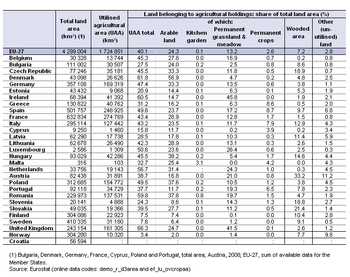Archive:Farm structure statistics
- Data from September 2011, most recent data: Further Eurostat information, Main tables and Database.
The structure of agriculture in the Member States of the European Union (EU) varies as a function of differences in geology, topography, climate and natural resources, as well as the diversity of regional activities, infrastructure and social customs. The survey on the structure of agricultural holdings, also known as the farm structure survey (FSS), helps assess the agricultural situation across the EU, monitoring trends and transitions in the structure of agricultural holdings, while also modelling the impact of external developments or policy proposals.
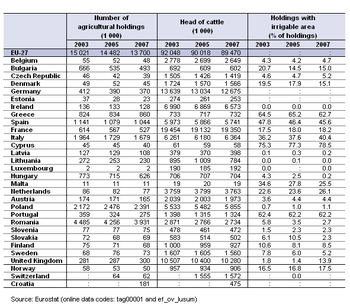
This article presents some statistics from the last farm structure survey that was conducted in 2007. The results of the most recent census (2009/2010) are in the process of being validated and first results should be available at the end of 2012.
Main statistical findings
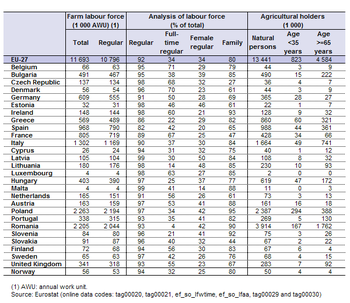
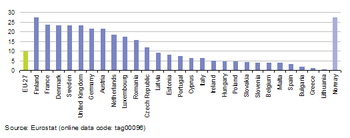
(%) - Source: Eurostat (tag00096)
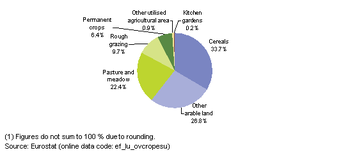
(% share of utilised agricultural area) - Source: Eurostat (ef_lu_ovcropesu)
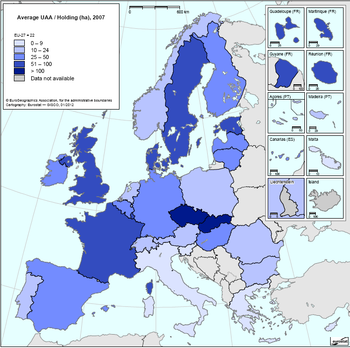
There were 7.3 million commercial agricultural holdings in the EU-27 in 2007, with a further 6.4 million small holdings (those below a threshold of one European size unit (ESU)). Almost half (48 %) of the small holdings in the EU-27, principally being subsistence in nature, were found in Romania. A little over one third of the EU-27’s commercial agricultural holdings (that were greater than one ESU) were located in Poland (15.5 %) and Italy (18.9 %), while Spain (12.8 %), Romania (11.9 %) and Greece (9.7 %) also contributed about a third of the total commercial holdings in 2007.
Among most Member States and across the EU-27 as a whole, there was a steady decline in the number of agricultural holdings during the period between 2003 and 2007. In this four-year period, the number of agricultural holdings in the EU-27 declined by 1.3 million (or 8.8 %), of which almost half were commercial holdings. There were particularly fast structural changes in Estonia, where the number of holdings declined by more than one third (-36.7 %), as well as in Bulgaria (-25.9 %), Portugal (-23.4 %) and Hungary (-19.0 %).
Cattle represent close to half of the total number of livestock units in the EU. In 2007 there were 89.5 million head of cattle in the EU-27, of which more than one fifth (21.6 %) were in France. Despite being one of the smallest EU Member States, Ireland had one of the largest cattle herds, accounting for 7.3 % of the EU-27 total.
The total farm labour force in the EU-27 was the equivalent of 11.7 million full-time workers in 2007, of which 10.8 million (92 %) were regular workers (see Table 2). Agriculture remains very much a family-oriented activity in the majority of Member States; four fifths (80 %) of the total agricultural labour force in 2007 were farm holders or members of their family. The main exceptions were Slovakia (44 %) and the Czech Republic (27 %), where there is a different ownership structure compared with the majority of Member States. Just over one third (34 %) of the regular agricultural labour force in the EU-27 was female, although in the Baltic Member States this share was closer to half, reaching 50 % in Latvia. Among EU-27 agricultural holders in 2007, relatively few (6 %) were under the age of 35, while a relatively high proportion (34 %) were aged 65 years or over.
Figure 1 indicates the proportion of farm holdings with another gainful economic activity. Besides agricultural activity, other gainful activities were also conducted by about one in ten (9.9 %) of the EU’s agricultural holdings in 2007, this proportion being slightly higher (13.5 %) among commercial holdings. A little over one quarter (27.6 %) of all holdings in Finland reported another gainful activity in 2007, with rates above 20 % also being recorded in Austria, Germany, the United Kingdom, Sweden, Denmark and France.
Two fifths (an estimated 40.1 %) of the total land area of the EU-27 was utilised agricultural area (UAA) in 2007. This proportion rose to two thirds (66.3 %) of the land area of the United Kingdom, but was less than one tenth of the total in Sweden and Finland. Arable land (which includes cereals and other arable land) accounted for a little less than one quarter (24.3 %) of the total land area of the EU-27, with permanent grassland (which is composed of pasture, meadow and rough grazing) accounting for 13.2 %. During the ten years through until 2007, the make-up of land use in the EU-27 did not change very much. Equally the overall area utilised by agriculture was relatively stable within the EU, although there was a slight tendency for an increase in the area among Member States that joined the EU in 2004 or 2007, with a small decrease in the EU-15 Member States.
Data sources and availability
A comprehensive farm structure survey is carried out by Member States every ten years (the full scope being the agricultural census) and intermediate sample surveys are carried out three times between these basic surveys. The Member States collect information from individual agricultural holdings. The information collected covers:
- land use;
- livestock numbers;
- rural development (for example, other gainful activities);
- management and farm labour input (including age, gender and relationship to the holder).
The survey data are aggregated to different geographic levels (Member States, regions, and for basic surveys also districts) and arranged by size class, area status, legal status of holding, objective zone and farm type.
The basic unit underlying the survey is the agricultural holding, a technical-economic unit under single management engaged in agricultural production. The survey covers all agricultural holdings with a utilised agricultural area (UAA) of at least 1 hectare (ha) and those holdings with a UAA of less than 1 hectare if their market production exceeds certain natural thresholds.
Other gainful activity is any activity other than that relating to farm work, including activities carried out on the holding itself (camp sites, accommodation for tourists, etc.) or that use its resources (machinery, etc.) or products (such as processing farm products, renewable energy production), and which have an economic impact on the holding. Other gainful activity is carried out by the holder, his/her family members, or one or more partners on a group holding.
The farm labour force is made-up of all individuals who have completed their compulsory education (having reached school-leaving age) and who carried out farm work on the holding under survey during the 12 months up to the survey day. The figures include the holders, even when not working on the holding, whereas their spouses are counted only if they carry out farm work on the holding. The holder is the natural person (sole holder or group of individuals) or the legal person (for example, a cooperative or other institution) on whose account and in whose name the holding is operated and who is legally and economically responsible for the holding – in other words, the entity or person that takes the economic risks of the holding; for group holdings, only the main holder (one person) is counted. The regular labour force covers the family labour force and permanently employed (regular) non-family workers. The family labour force includes the holder and the members of his/her family who carried out farm work (including all persons of retiring age who continue to work on the holding). One annual work unit (AWU) corresponds to the work performed by one person who is occupied on an agricultural holding on a full-time basis. Full-time means the minimum hours required by the national provisions governing contracts of employment. If these provisions do not explicitly indicate the number of hours, then 1 800 hours are taken to be the minimum (225 working days of eight hours each).
In preparation for the 2010 survey a new legal basis was developed: Regulation (EC) 1166/2008 of the European Parliament and of the Council of 19 November 2008 on farm structure surveys and the survey on agricultural production methods.
Context
Rural development policy aims to improve: competitiveness in agriculture and forestry; the quality of the environment and countryside; and life in rural areas; and the diversification of rural economies. As agriculture has modernised and the importance of industry and services within the economy has increased, so agriculture has become much less important as a source of jobs. Consequently, increasing emphasis is placed on the role farmers can play in rural development, including forestry, biodiversity, the diversification of the rural economy to create alternative jobs and environmental protection in rural areas. The common agricultural policy (CAP) is due to be reformed by 2013 and this is likely to have an impact on rural development policies. The farm structure survey continues to be adapted with the aim of trying to provide timely and relevant data to help analyse and follow these developments.
Further Eurostat information
Publications
- Agricultural statistics - Main results 2008-09 (Pocketbook)
- Agriculture – Main statistics 2005-2006 (Pocketbook)
Main tables
- Agriculture (t_agri), see:
- Structure of agricultural holdings (t_ef)
Database
- Agriculture (agri), see:
- Structure of agricultural holdings (ef)
- Overview of agricultural holdings (ef_ov)
- Land Use (ef_lu)
- Livestock (ef_ls)
- Special interest topics (ef_so)
- Standard gross margin (SGM) coefficients used for typology (ef_tsgm)
- Standard output (SO) coefficients used for typology (ef_tso)
- Structure of agricultural holdings by region, main indicators (ef_r_main)
Dedicated section
Methodology/Metadata
- Structure of agricultural holdings (ESMS metadata file - ef_esms)
Source data for tables, figures and map (MS Excel)
Other information
- Commission Decision 85/377/EEC of 7 June 1985 establishing a Community typology for agricultural holdings
- Commission decision 115/2000 of 24 November 1999 relating to the definitions of the characteristics, the list of agricultural products, the exceptions to the definitions and the regions and districts regarding the surveys on the structure of agricultural holdings
- Regulation 571/88 of 29 February 1988 on the organization of Community surveys on the structure of agricultural holdings between 1988 and 1997
External links
See also
- Agricultural census
- Agri-environmental statistics
- Farm structure evolution
- Farm structure survey (FSS)
